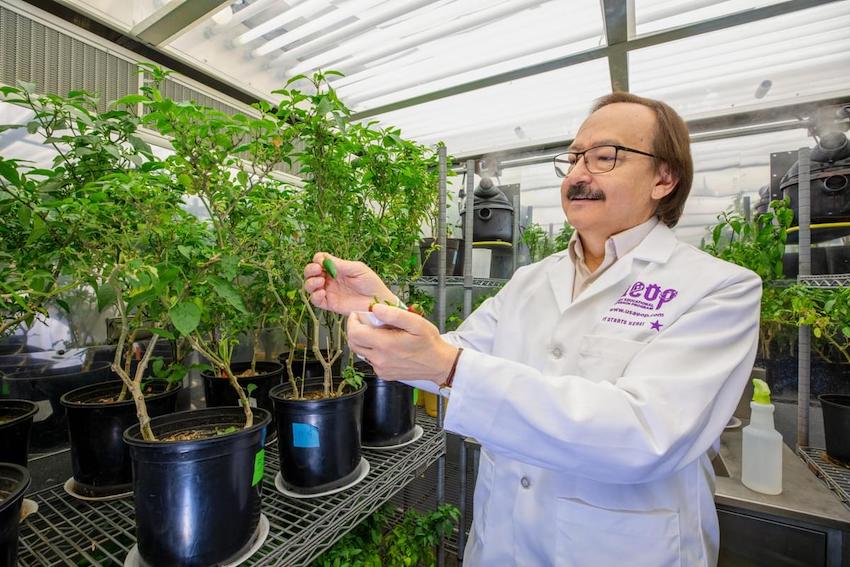
UTEP Leaps into the Future with New X-ray Facility at Cornell
Cutting-edge facility to support research, graduate education
El Paso, TEXAS (March 7, 2024) – Researchers at The University of Texas at El Paso are collaborating with the Cornell High Energy Synchrotron Source (CHESS) on the development of a precision X-ray beamline that will significantly advance the two universities’ agricultural and environmental research.

The beamline is funded by a new $20 million grant from the National Science Foundation (NSF), approximately $1.3 million of which will go to UTEP.
“This project with CHESS will open the doors to exciting new research and innovation for UTEP students and faculty,” said Carlos Cabrera, Ph.D., professor and chair of the Department of Chemistry and Biochemistry and UTEP’s principal investigator on the project.
The NSF funds support the construction of the X-rays for Life, Environmental, Agriculture and Plant sciences (XLEAP) beamline at Cornell, which will focus on research into plant life, the carbon cycle, soil and other topics important to environmental science and biology. The beamline will also feature a unique growth chamber where researchers can grow plants for research purposes.
UTEP graduate students will be employed to help construct the beamline, and through internships at CHESS, will learn to operate synchrotrons — massive devices that are used to rapidly accelerate electrons. Synchrotrons emit an intense light that can be used to see matter at the atomic or sub-atomic level.
Beamlines are constructed as offshoots of a synchrotron to capture selective types of radiation emitted by electrons as they travel. The radiation can be used to create highly precise X-rays, enabling scientists to see more deeply into the matter they are studying.
"This exciting collaboration, generously funded by the NSF, brings together our College of Science with the prestigious Cornell High Energy Synchrotron Source,” said Robert Kirken, Ph.D., dean of the College of Science. “Through this partnership, our faculty and students from biology, chemistry, geology and physics will be able to utilize cutting-edge X-ray imaging techniques. This invaluable resource will allow us to embark on innovative research endeavors, fostering interdisciplinary collaboration and driving scientific progress."
One project underway at UTEP that will benefit from the new beamline involves studying metal uptake in plants. Some metals, such as iron and manganese, are naturally taken up by plants from the soil and can be beneficial to human health. Others, such as lead, are harmful to both the plants and humans if absorbed.
Cabrera explained that as metals travel through a plant’s roots, stems and leaves, they emit fluorescent light that is unique to each metal when illuminated by X-rays. The up-and-coming beamline can be used to X-ray the plants and view the light emitted by each metal, allowing the researchers to observe how — and how fast — the metals are moving through the plant. This, in turn, can help them understand possible risks to human health in agricultural crops and design precisely targeted nano-fertilizers that can maximize the presence of beneficial metals and improve photosynthesis and crop production.
“This is a dream come true after many years of doing synchrotron work,” said Jorge Gardea-Torresdey, Ph.D., professor of chemistry and a co-PI on the project. “This research will give us a much deeper insight that we can use to vastly improve agriculture.”
The research team, which has a long-standing relationship with Cornell University, also includes Assistant Professors Jose Angel Hernandez-Viezcas, Ph.D., and Sreeprasad T. Sreenivasan, Ph.D., in the Department of Chemistry and Biochemistry.
About The University of Texas at El Paso
The University of Texas at El Paso is America’s leading Hispanic-serving university. Located at the westernmost tip of Texas, where three states and two countries converge along the Rio Grande, 84% of our 24,000 students are Hispanic, and more than half are the first in their families to go to college. UTEP offers 172 bachelor’s, master’s, and doctoral degree programs at the only open-access, top-tier research university in America.
Last Updated on March 07, 2024 at 12:00 AM | Originally published March 07, 2024
By MC Staff UTEP Marketing and Communications
